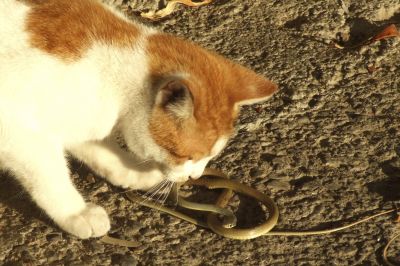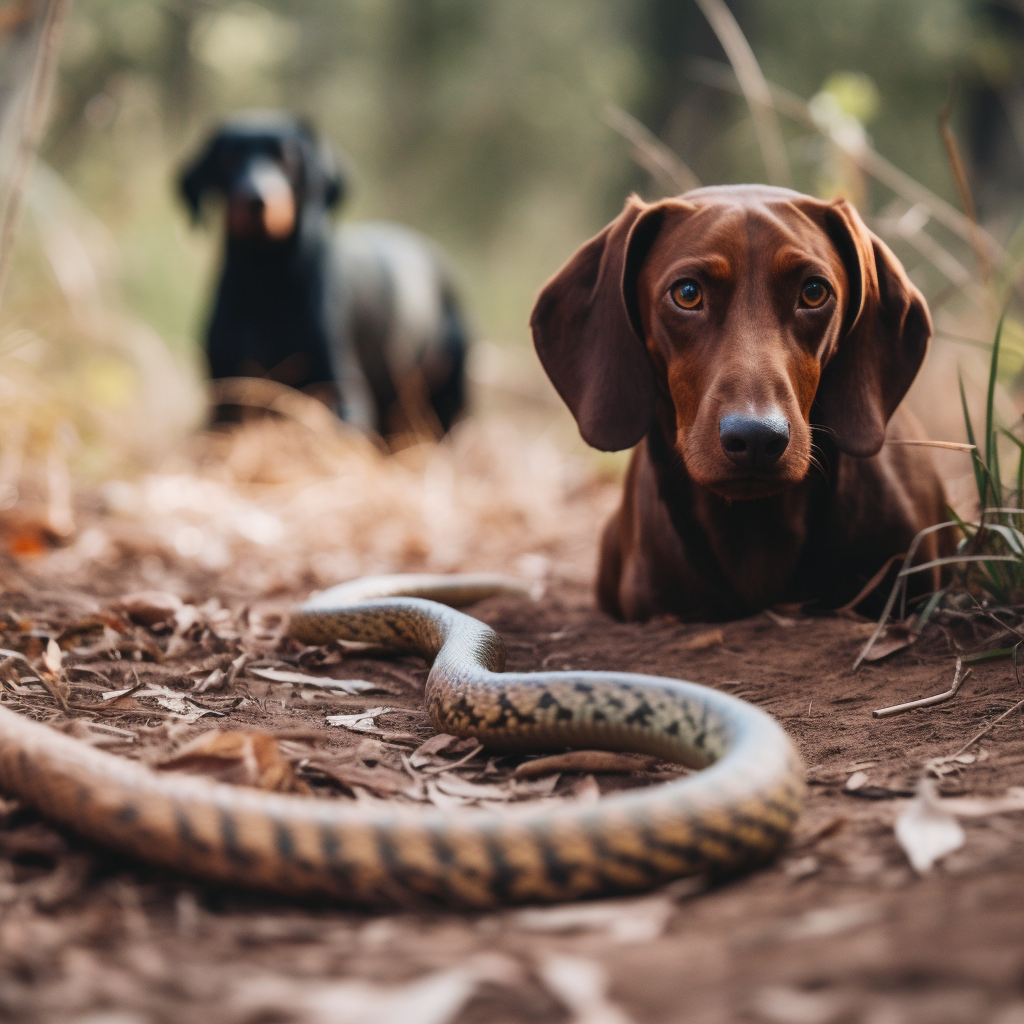Every Spring and Summer we see a number of cases of snake-bite in dogs and cats.
I was given a real-life reminder this week, whilst walking my dogs, that snake-bite season is already upon us!
The Risk of Snakes in Australia!
As reptiles, snakes are cold-blooded creatures and rely on environmental conditions to warm themselves. As such, they lie dormant throughout most of winter before coming back into action at the first signs of a warm, sunny day.
As it happens, last Saturday was just such a day – the first signs of Spring this year. I took advantage of this by taking the dogs out for a good walk after I finished work.
Whilst walking through the gully at the bottom of our place, I just missed out on stepping on a large adult brown snake.
Actually, I would have trodden right on him if it weren’t for the fact one of the dogs went running by a moment earlier and disturbed said snake from his slumbers!

I managed to change direction (in mid-step!) and so avoided annoying the snake even further – lucky me!
Of course, snakes are present throughout this part of the world (probably far more than we’re aware of) with brown snakes particularly prevalent around my area.
The reason we don’t see them very often is that they are generally pretty shy creatures. They’ll avoid us, if at all possible, and only become aggressive if cornered.
Most of us are smart enough to figure out that it’s not such a good idea to corner a large brownie and so don’t often come to blows with one (unless, of course, we’re silly enough to trod on one while walking along and daydreaming!).
With cats and dogs, however, it’s an entirely different situation!
Both dogs and cats are predators and cats, in particular, are very efficient hunters. When confronted with a snake, they’re very likely to go on the attack, and this is where problems occur.
Although both dogs and cats are very capable of killing even the largest adult brown snake, it’s just as likely the snake will get in a few blows of its own.
Of course these blows take the form of a bite and brown snakes happen to be the second most venomous snake on planet earth!
The Dangers of Brown Snake Venom to our Pets
The effects of brown snake venom are frequently lethal and can be very rapid.
The venom is a potent neuro-toxin and can quickly result in respiratory and cardiac failure.
Although cats can take several hours to become affected, dogs can die within half an hour of being bitten.
What to do if your Pet is Bitten by a Snake
Pet owners often ask what they can do if they think their pet has been bitten. Given the timing I’ve just described above, it’s probably pretty clear that snakebite is a flat out emergency.
Even if you’re not sure whether there has actually been a bite, you need to your vet as soon as possible!! Phone them when you’re on the way (if you can) to alert them, but definitely don’t hang around on your way there.
How do Vets Treat a Snakebite?
Well, as mentioned, the first thing is a very rapid response, particularly with dogs.
Each veterinary surgery will have a protocol for treating snakebite. Often the first thing your vet will do is put your pet on intravenous fluids. This means they will have rapid access for treatment.
Your vet will then run a couple of simple and quick tests which should give a very good idea of whether there is any venom in the system. If this proves to be the case, they’ll treat your pet with a combination of anti-histamines and then anti-venine.
Unless your vet is certain the snake is a from a brown snake (brownie), they’ll often use a combination anti-venine (red-bellied black snakes can also occur around here although more so in the hills zone).
In dogs, the response to treatment is often very rapid, and as long as you get your pet to the vet in time, your pet can be home within 24 hours. With cats, if they’re already affected by the venom, full recovery can take several days of hospital care.
What can You do to Avoid Snakebites near your Home?
Well, not much you can say to your pets to dissuade them from attacking a snake when they’re in hunting or excitement mode so the best thing is avoidance.
Make sure you keep all long grass mown down in any areas your pets have easy access.
Also, don’t leave piles of wood or rubbish as this is frequently where snakes hang out.
If you’ve already seen a snake in your yard, then it’s a great idea to call a snake-catcher (look up on the web for your closest service, or ask on a community Facebook group).
There are several ‘snake posts’ on the market and some people swear by them – they are designed to deter snakes by giving off a constant vibration in the ground. Not sure how well they work, but worth looking into.
While the return of winter over the last few days will send the snakes back into a sleepy state, it shouldn’t be long until they’re on the move again.
When this happens, you need to be really aware and on the lookout for signs of danger for your pets.
If you think there’s any chance your pet has been bitten, call your vet immediately and get them in pronto. Better to be safe than sorry – don’t let your pet be a victim of snakebite season this year!!
Related: Snakebites in Dogs
Wishing you safety!
David



Leave a Reply